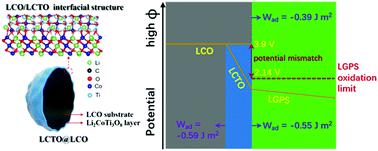当前位置:
X-MOL 学术
›
Energy Environ. Sci.
›
论文详情
Our official English website, www.x-mol.net, welcomes your feedback! (Note: you will need to create a separate account there.)
Engineering the interface between LiCoO2 and Li10GeP2S12 solid electrolytes with an ultrathin Li2CoTi3O8 interlayer to boost the performance of all-solid-state batteries
Energy & Environmental Science ( IF 32.5 ) Pub Date : 2020-11-21 , DOI: 10.1039/d0ee03212c Chuan-Wei Wang 1, 2, 3, 4 , Fu-Cheng Ren 1, 2, 3, 4 , Yao Zhou 1, 2, 3, 4 , Peng-Fei Yan 4, 5, 6, 7, 8 , Xiao-Dong Zhou 9, 10, 11, 12, 13 , Shao-Jian Zhang 1, 2, 3, 4 , Wen Liu 4, 14, 15 , Wei-Dong Zhang 4, 16, 17 , Ming-Hua Zou 4, 16, 17 , Lei-Ying Zeng 4, 16, 17 , Xia-Yin Yao 4, 18, 19, 20 , Ling Huang 2, 3, 4, 21, 22 , Jun-Tao Li 1, 2, 3, 4 , Shi-Gang Sun 2, 3, 4, 21, 22
Energy & Environmental Science ( IF 32.5 ) Pub Date : 2020-11-21 , DOI: 10.1039/d0ee03212c Chuan-Wei Wang 1, 2, 3, 4 , Fu-Cheng Ren 1, 2, 3, 4 , Yao Zhou 1, 2, 3, 4 , Peng-Fei Yan 4, 5, 6, 7, 8 , Xiao-Dong Zhou 9, 10, 11, 12, 13 , Shao-Jian Zhang 1, 2, 3, 4 , Wen Liu 4, 14, 15 , Wei-Dong Zhang 4, 16, 17 , Ming-Hua Zou 4, 16, 17 , Lei-Ying Zeng 4, 16, 17 , Xia-Yin Yao 4, 18, 19, 20 , Ling Huang 2, 3, 4, 21, 22 , Jun-Tao Li 1, 2, 3, 4 , Shi-Gang Sun 2, 3, 4, 21, 22
Affiliation

|
Sulfide-based all-solid-state lithium-ion batteries (ASSLIBs) are promising candidates in the next generation of energy storage technology; the voltage mismatch and the resulting side reactions at the interface between the cathode and the solid electrolyte, however, dramatically deteriorate their cycling performance. Herein, for the first time, we report that the chemical interaction between LiCoO2 (LCO) and TiO2 can be regulated by two additives, carbon and Li2CO3, which in situ form a continuous ultrathin pure-phase Li2CoTi3O8 (LCTO) layer with a stable 3D network of spinel structures, relatively low electronic conductivity (2.5 × 10−8 S cm−1) and high lithium diffusion coefficient (DLi+ = 8.22 × 10−7 cm2 s−1) on the surface of LCO. When assembled in ASSLIBs, such an LCTO layer functions as an interlayer between the LCO and the Li10GeP2S12 solid electrolyte (LGPS). As a consequence, the original interface LCO/LGPS is substituted by two new interfaces LCO/LCTO and LCTO/LGPS. DFT calculations indicate that, compared with the LCO/LGPS, the new interfaces are not only thermodynamically and electrochemically more compatible, but also have higher interfacial affinity. Therefore, the relevant ASSLIB exhibits evidently reduced interfacial impedance, and it also displays a high initial capacity of 140 mA h g−1 and a reversible discharge specific capacity of 116 mA h g−1 after 200 cycles at room temperature (0.1C). In comparison, the ASSLIB assembled without the LCTO interlayer delivers an initial capacity of 98 mA h g−1 and only retains 22.4% capacity after 100 cycles (0.1C). Even at a high cutoff voltage (4.5 V vs. Li/Li+), the ASSLIB with the LCTO interlayer could also exhibit a high initial capacity of 180 mA h g−1 and a remarkable retention of 132 mA h g−1 after 100 cycles.
中文翻译:

用超薄的Li2CoTi3O8中间层对LiCoO2和Li10GeP2S12固体电解质之间的界面进行工程设计,以提高全固态电池的性能
基于硫化物的全固态锂离子电池(ASSLIB)是下一代储能技术的有希望的候选者;然而,电压失配以及在阴极和固体电解质之间的界面处产生的副反应会大大降低其循环性能。本文中,我们首次报道了LiCoO 2(LCO)和TiO 2之间的化学相互作用可以通过两种添加剂调节,碳和Li 2 CO 3可以原位形成连续的超薄纯相Li 2 CoTi 3。 Ø 8(LCTO)层具有稳定的尖晶石结构3D网络,较低的电子电导率(2.5×10 -8 S cm -1)和较高的锂扩散系数(D Li + = 8.22×10 -7 cm 2 s -1) LCO的表面。当组装在ASSLIB中时,此类LCTO层将充当LCO和Li 10 GeP 2 S 12之间的中间层固体电解质(LGPS)。结果,原始接口LCO / LGPS被两个新接口LCO / LCTO和LCTO / LGPS取代。DFT计算表明,与LCO / LGPS相比,新界面不仅在热力学和电化学方面更兼容,而且具有更高的界面亲和力。因此,相关的ASSLIB表现出明显降低的界面阻抗,并且还显示出在室温(0.1C)下200个循环之后的140mA hg -1的高初始容量和116 mA hg -1的可逆放电比容量。相比之下,在没有LCTO中间层的情况下组装的ASSLIB的初始容量为98 mA hg -1并且在100个循环(0.1C)之后仅保留22.4%的容量。即使在高截止电压(4.5 V vs. Li / Li +)下,具有LCTO中间层的ASSLIB也可表现出180 mA hg -1的高初始容量,并在100次循环后仍具有132 mA hg -1的显着保留率。
更新日期:2020-12-14
中文翻译:

用超薄的Li2CoTi3O8中间层对LiCoO2和Li10GeP2S12固体电解质之间的界面进行工程设计,以提高全固态电池的性能
基于硫化物的全固态锂离子电池(ASSLIB)是下一代储能技术的有希望的候选者;然而,电压失配以及在阴极和固体电解质之间的界面处产生的副反应会大大降低其循环性能。本文中,我们首次报道了LiCoO 2(LCO)和TiO 2之间的化学相互作用可以通过两种添加剂调节,碳和Li 2 CO 3可以原位形成连续的超薄纯相Li 2 CoTi 3。 Ø 8(LCTO)层具有稳定的尖晶石结构3D网络,较低的电子电导率(2.5×10 -8 S cm -1)和较高的锂扩散系数(D Li + = 8.22×10 -7 cm 2 s -1) LCO的表面。当组装在ASSLIB中时,此类LCTO层将充当LCO和Li 10 GeP 2 S 12之间的中间层固体电解质(LGPS)。结果,原始接口LCO / LGPS被两个新接口LCO / LCTO和LCTO / LGPS取代。DFT计算表明,与LCO / LGPS相比,新界面不仅在热力学和电化学方面更兼容,而且具有更高的界面亲和力。因此,相关的ASSLIB表现出明显降低的界面阻抗,并且还显示出在室温(0.1C)下200个循环之后的140mA hg -1的高初始容量和116 mA hg -1的可逆放电比容量。相比之下,在没有LCTO中间层的情况下组装的ASSLIB的初始容量为98 mA hg -1并且在100个循环(0.1C)之后仅保留22.4%的容量。即使在高截止电压(4.5 V vs. Li / Li +)下,具有LCTO中间层的ASSLIB也可表现出180 mA hg -1的高初始容量,并在100次循环后仍具有132 mA hg -1的显着保留率。



























 京公网安备 11010802027423号
京公网安备 11010802027423号